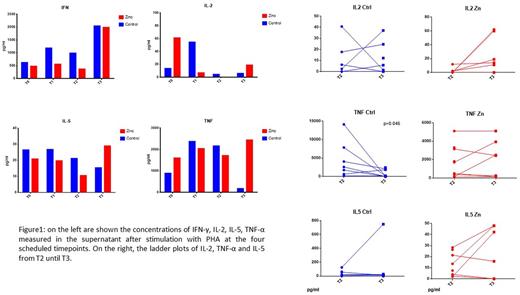Abstract
Introduction: the immune system may take months to recover after hematopoietic stem cell transplantation (HSCT). One important factor involved in the immune reconstitution is the recovery of the thymic production of a new T-cell repertoire, the other is the homeostatic peripheral expansion of mature lymhpocytes (HPE). It is known that HPE affect in a negative way the killing functions of the mature lymphocytes and their ability in secreting cytokines. On the other hand, the production of recent thymic emigrants (RTEs) by the thymus confers a broader spectrum against pathogens, but it needs a longer time. Zinc is fundamental for immune cells: several studies demonstrated that Zinc causes regrowth of thymic epithelial cells (TECs) in adults, improving the production of RTEs. Many studies showed the ability of Zinc to improve the in vitro cytokine release from immune cells, and others demonstrated its anti-apoptotic role on mature lymphocytes. As described elsewhere, we performed a clinical trial with the aim of investigating a potential therapeutic role of Zinc after HSCT (ZENITH trial). Here we illustrate the results of the cytokine release assays performed on the peripheral blood mononucleated cells (PBMC) isolated from the patients participating to the ZENITH trial.
Patients and methods: From January 2015 to May 2016, we prospectively enrolled 19 patients affected by multiple myeloma (12 males, 7 females) undergoing single MEL 100 or 200 auto-SCT after one or two lines of therapy and stem cell collection. The trial, prospective and randomized, has been approved by local ethics committee (EUDRACT: 2014-004499-47). All patients undersigned the informed consent. The clinical trial was carried out in accordance with Helsinki declaration. Randomization was performed at day 0 (day of PBSC infusion). Ten patients were treated from day +5 to day +100 after transplant only with standard antimicrobial prophylaxis, whereas nine patients received in addition 600 mg/day of Zinc sulfate (uncoated tablets). Peripheral blood samples were collected in both groups at 4 timepoints (T0: day of stem cell collection; T1: day before conditioning; T2: day +30 after HSCT; T3: day +100 after HSCT). Absolute lymphocyte count was performed with an automatic counter. PBMC were obtained by separation on Ficoll gradient. 3x105/well cells were seeded in 48 w's plates and stimulated with RPMI 5%AS, PHA 2µg/ml. Supernatants were collected after both 3 and 5 days from stimulation and immediately frozen. Cytokines in the supernatants were evaluated by sandwich ELISA using R&D System Duo Set assays. All the values are expressed in picograms/ml. We dosed the levels of 4 cytokines: gamma-IFN, IL-2, IL-5 and alpha-TNF. On the basis of the literature, we considered the day +3 as the best time to measure IL-5 and TNF and the day +5 for IFN and IL-2. Non-parametric tests have been used for case-control analyses and for intra-group diachronic analyses. Spearman test has been performed for correlation tests.
Results: The median levels of IFN increased both in the Zinc and in the Control group at day +100 after transplant. The release of IL-2 was higher in the Zinc group at T0; then, it was reduced respect to pre-transplant level at T2 in both groups, whereas it slightly rose from T2 until T3. The secretion of IL-5 in the Control group decreased from T0 until T3, whereas it increased from T2 until T3 in the Zinc group. TNF levels in T1 were higher than in T0 in both groups. Their levels remained stable at T2, but their median value increased in the Zinc group at T3, when they were reduced in the Control group (p=0.046). All the other above-described trends did not reach statistically significance, due to the still low number of patients enrolled. There was no correlation between absolute lymphocyte count and cytokine levels (p>0.05).
Conclusion: preliminary data from our pilot study show that the secretion of different cytokines undergoes changes before and after HSCT. Moreover, PBMC isolated from patients treated with Zinc supplementation presented higher levels of IL-2, IL-5 and TNF at day +100 after HSCT when stimulated with PHA. The ability of releasing cytokine depends from the functional status of lymphocytes and the most represented T-cells subpopulations. Studies with larger cohorts of patients and stimulation test on separated T-lymphocyte populations will clarify whether the Zinc may contribute in the rejuvenation of immune system after transplant.
Galimberti: Novartis: Speakers Bureau; Pfizer: Speakers Bureau; Bristol-Myers Squibb: Speakers Bureau; Incyte: Speakers Bureau.
Author notes
Asterisk with author names denotes non-ASH members.


This feature is available to Subscribers Only
Sign In or Create an Account Close Modal